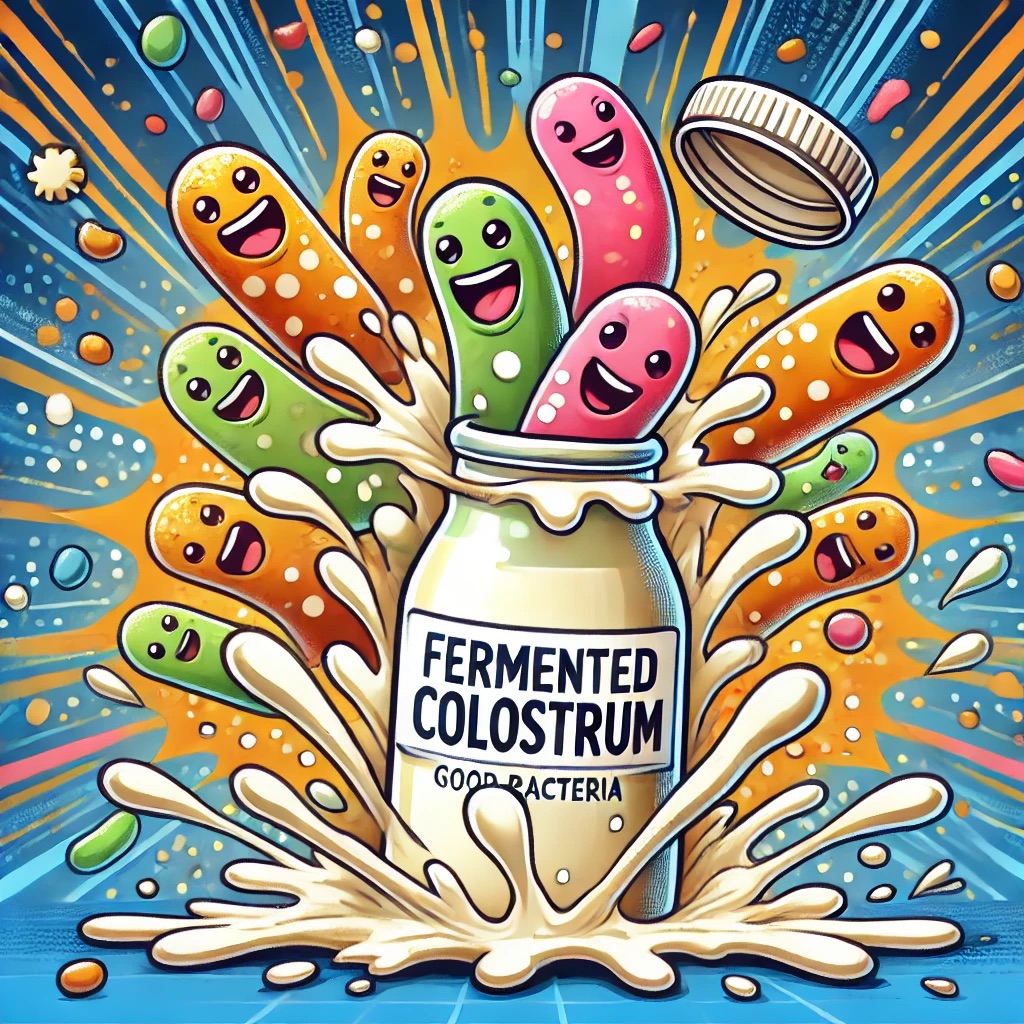How to Ferment Raw Colostrum with Bifidobacterium
 Though raw colostrum has plenty of benefits, it also contains a lot of fat. The reality is, some people’s digestive systems just don’t break down fats well. One example of this was my daughter, who would have stomach aches after the thicker batches of colostrum. At her worst, she even had asthma attacks from it.
Though raw colostrum has plenty of benefits, it also contains a lot of fat. The reality is, some people’s digestive systems just don’t break down fats well. One example of this was my daughter, who would have stomach aches after the thicker batches of colostrum. At her worst, she even had asthma attacks from it.
So does that mean these “intolerant” people should give up on the colostrum? No, it just means to ferment it instead. This helps break down the fats and other complex molecules so they are pre-digested before consumption. When I didn’t ferment the colostrum, my daughter would often have issues with it. After fermenting it, she has never had a problem. In addition, there are other benefits to fermenting it. Most importantly, it works even better since it increases bioavailability and acts as a carrier for the bifidobacterium.
How to Ferment Raw Colostrum with Bifidobacterium
Creating the Bifidobacterium Culture
The most important step of the process is creating a strong mother culture of bifidobacterium.
Ingredients– This will require 12 pills from PROBIOTA BIFIDO by Seeking Health. It will also require 1 pound of inulin, which you can get many places but I like bulkfoods.com the most. It also requires a good spring or artesian water. Believe it or not, water quality does make a difference.
Mixing Instructions – Find a half-gallon plastic container with a screw on top. Ideally, we want the plastic to be a harder type of plastic. Fill up the container about 2/3 of the way with water, and then add eight heaping tablespoons of inulin to water and shake aggressively. Afterward, add the 12 capsules of bifido and shake again. Place it in a dark location, like a cabinet.
Maintenance– Shake it four or five times per day if possible. Once the plastic bottle starts to develop more and more pressure, you know you are on the right track. If you do not see the bottle expand, then maybe you didn’t use enough inulin. Keep shaking daily for about 5 to 7 days. Relieve pressure slightly as needed by opening the bottle a little bit.
Growing the Culture – Once it has fermented for roughly a week and is highly active, then it is time to use that as the master culture to grow more. Get a gallon jug with a twist top and hopefully make it harder plastic. Transfer your fermented liquid into the gallon container and double up the water. Then add 10 more heaping tablespoons of inulin. Shake aggressively a few times every single day.
Within a week or so, you will have close to a gallon’s worth. This will allow you to have plenty when fermenting the colostrum. Ideally, you never want to use the last of the culture to create your fermented colostrum. When you get below a half gallon, replenish the water, add a bunch of inulin and put more probiotics in. Keep shaking it like you care about it, and this never-ending bifido culture will thank you!
Using the Bifido Culture to Ferment Colostrum
Mixing– To ferment the colostrum, you must mix the bifido liquid together with it. The proper ratio is about 30% Bifido liquid to 70% colostrum. If the colostrum is super thick, maybe use upwards of 40% bifido. You can mix them together just by shaking it or you can blend it. After they are mixed together, add a few more tablespoons of inulin and shake aggressively. Then, store it in a dark place for 3 to 5 days, and shake it 5 to 6 times the first day.
In the remaining days, shake at least four times. Please be aware of the pressure that can build. If you are not paying close enough attention, the plastic containers can explode. Release the air slowly and close the container immediately. Too much exposure to air can ruin the end product.
Storing– After it has been fermented for 4 or 5 days, you can store it in the refrigerator. From there, it will stay good for several months. You just need to make sure you shake it at least once per day when it’s in the fridge. If you don’t remember to shake it, it won’t go bad, but by shaking it, it will keep the good bacteria awake and thriving. I find it is best to create 2 gallons at a time. This allows me to have enough for a month or two since it does take some time.
Example of Good Batch of Fermented Colostrum
Want to see how it should look if it’s done right? Take a look at the video below. As you can see, there was so much pressure from the fermentation it blew the top off and hit the ceiling. My daughter even was scared!! Potent stuff to say the least!
FAQ- Fermenting Colostrum to Increase Tolerance and Bioavailability
Is this process really worth the time it takes?
Yes, especially for the people who can’t tolerate the colostrum otherwise. Even for those who can consume it raw, it is still more potent after fermentation. Not only is it a supercharged probiotic with tons of pre-digested prebiotics in it, but by fermenting, you also increase the bio-availability of many components.
What are the potential benefits of using raw colostrum?
To learn more about the potential benefits of colostrum read this article – Raw Bovine Colostrum – Ultimate Superfood for Healing. Keep in mind, this article is about regular bovine colostrum. By fermenting it correctly, it’s potential can be even greater than what you will see in that article.
Does every batch of fermented colostrum turn out the same?
No, but most of the time they do. Sometimes, you have colostrum that is much thicker or thinner. Also, there are times when the probiotic capsules, for some reason, seem less active. Of course, the type of inulin and the amount you use also plays a part in your success. Though it may take a few times to get it down, it’s worth the trial and error. Keep in mind, I’m always willing to help, so feel free to reach out.
Can I use different probiotic supplements to ferment colostrum?
Honestly, it has never worked well with any other brand. Also, you don’t want any lactobacillus species because they will create too much acid, which will degrade the bioavailability in the colostrum. In addition, many of those strains are not immune modulators like bifidobacterium. The only other thing I have used in the past was kefir grains. When I did this, I added a lot of FOS and blended them with the colostrum. Though it did work, it was not as beneficial as the bifido method.
How long will the bifido liquid stay good outside of the fridge?
If it is done right, it doesn’t go bad. I have had mother cultures for several months. The fermentation process creates SCFA’s which preserve the liquid. The most important part is just to remember to shake it 1-2x every day if you can.
Can I drink the bifidobacterium liquid on its own?
Yes, just make sure you have plenty to keep fermenting the colostrum. In the end, the bacteria are much more likely to implant when insulated by the colostrum. This protects them from stomach acids and other things that could kill them.
Why did you choose bifidobacterium to ferment colostrum?
Bifidobacterium is the most important strain for keeping the immune system calm. It does not produce lactic acid like other strains, which allows it to ferment for longer without ruining the bioavailability. Lastly, fermenting is most likely to create immune-modulating by-products.
How often and how much should I drink?
Ideally, two days on, one day off or something like that. It all depends on the situation, quite frankly. You have to ease your way into this because you are introducing tons of bacteria, and if you do it too quickly, it could be uncomfortable. These bacteria will break up debris from the walls of your colon and start flushing things out. Start slow and gradually increase until at a dose of 10 ounces or so. The max I would do is five days per week, and make sure to take a week off every few months. In addition, make sure to consume plenty of plant fiber to support the growth of the bifidobacterium.
Using the Fermented Colostrum Properly
I am blessed to have discovered this method for fermenting colostrum. Even though this can be a game changer, it doesn’t mean you don’t have to make other changes. The fermented colostrum will be only as effective as the rest of your plan. This includes key areas such as diet, supplements, indoor air quality, and stress.
If you have questions about fermenting colostrum, or creating a health plan that works for you, contact me.
Happy healing everyone!
Matt Nedin, B.S.
Certified Holistic Nutritionist
EndSickness, Founder
Phone: (734) 846-8619
WhatsApp: +17348468619
Email: endsickness@gmail.com









